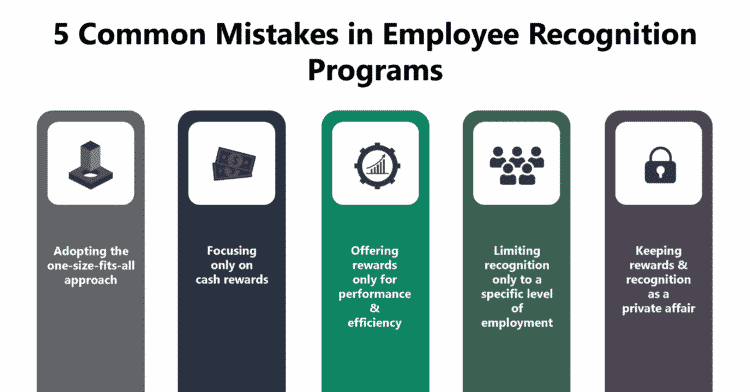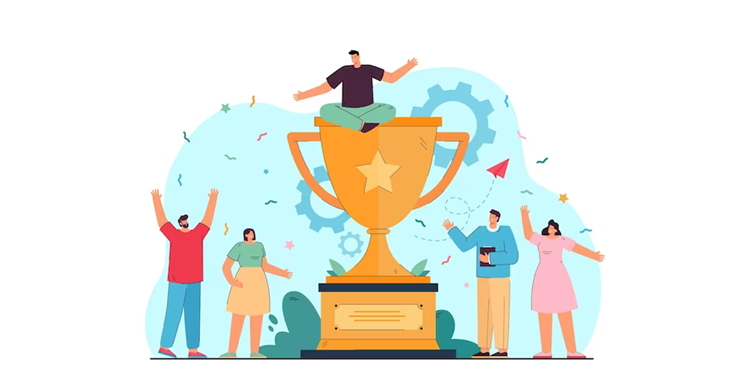1. One-Size-Fits-All Approach: Using the same recognition method for all employees, ignoring their diverse needs.
2. Focusing Only on Cash Rewards: Relying solely on monetary rewards, which can lose their impact over time.
3. Rewarding Only Performance and Efficiency: Limiting recognition to just performance metrics, neglecting other valuable contributions.
4. Limiting Recognition to Junior Employees: Overlooking mid and senior-level employees who also need recognition.
5. Making Recognition Private: Keeping recognition low-key, missing the motivational boost of public acknowledgment.
The key objective of rewards and recognition programs is to appreciate and celebrate employee achievements and make them feel valued. Recognition programs often fail due to organizational mistakes while developing and implementing them. Here are the five most common errors in employee recognition programs and the best ways to avoid them.
1. Adopting a One-size-fits-all Approach
2. Focusing only on Cash Rewards
3. Offering Rewards for Performance and Efficiency only
4. Limiting Recognition only to Junior Employees
5. Making Rewards and Recognition Private


Most organizations feel that a common approach is the best strategy for recognizing and rewarding employees.
However, such an approach often fails because the workforce comprises individuals with varying demographics and motivational factors.
This “one-size-fits-all” approach makes rewards and recognition a mere formality and fails to generate the desired results.
To avoid this, organizations should develop a flexible rewards system customized to the needs and expectations of different workforce segments.

Many organizations consider monetary rewards the best way to motivate employees across all levels.
However, focusing only on the cash without appreciating the efforts or achievements of employees may not prove as effective.
While employees might appreciate the additional money they receive, it might not motivate them for long.
Moreover, cash rewards tend to lose their novelty over time and may fail to generate enough excitement among recipients.
On the other hand, non-monetary rewards tend to have a longer-term impact and are generally more effective.
Organizations should create an employee recognition system with monetary and non-monetary rewards components.

Organizations that base rewards only on employee performance and efficiency will likely get poor results. While they are essential factors, they should not be the only criteria for reward and recognition.
Due to this, the same employees may get rewards repeatedly simply because they are more efficient and better performers.
When recognizing employees, organizations should consider additional factors, such as initiatives taken, process improvement, display of values, and innovation.
This can help make the reward programs more inclusive and ensure greater participation from the workforce.

One common mistake by organizations is to limit the program coverage to only employees within specific levels.
These organizations tend to skip the mid and senior-level employees, thinking that they are self-motivated and don’t require such recognition.
They might not understand that even senior professionals desire recognition as much, and sometimes even more than their juniors.
Organizations should develop a comprehensive reward and recognition system applicable across all levels of the organization.
It should have various categories of recognition, including different levels of employees, so that the system is relevant to all.

Often, organizations keep reward and recognition low-key affairs and do not have proper announcements or presentation ceremonies.
This can make the entire process of recognition ineffective.
Employees feel elated when they are appreciated and rewarded publicly and their co-workers hear about their hard work and achievements.
That is why organizations should make every effort to communicate effectively about the rewards and recognition,
Being aware of the common mistakes in employee recognition programs can help organizations get higher ROI from such programs and drive enhanced productivity and a greater sense of commitment and loyalty from their workforce.

Lead author: Sagar Chaudhuri, the Co-Founder and CEO of HiFives. He is an HR Tech Evangelist with over 25 years of corporate and entrepreneurship experience. In the past, Sagar has worked in leadership roles with companies such as Genpact, Infosys, and ICICI Bank. He has an engineering degree from IIT Kharagpur and an MBA from IIM Lucknow. Connect on LinkedIn
To stay updated on the latest HiFives blogs, follow us on Twitter (@MyHiFives)